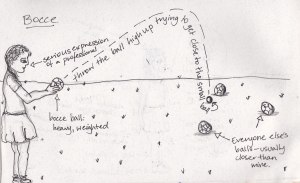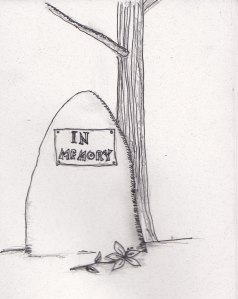From 1993-1999, I attended Mt. Whitestone State School, a small school about fifteen minutes outside of Gatton (when people asked ‘where’s Gatton?’ we would say, ‘you drive along the Warrego highway and fall into a hole’). Next year the school is 150 years old.
I can picture the school, although I haven’t been there for years. The grounds rise in a gentle slope from the road. There is a strip of land at the front, severed from the rest of the school by an invisible boundary; we were only allowed there in the afternoons while we waited for our parents. We used this time well, and transformed the grass into a field for Tiggy and Red Rover (all the other equipment had been put away in the sports room, so we had to rely on our own bodies for entertainment).
The old school house is half hidden by a garden of gums and shrubs, which in summer bloom with purple and white flowers. On one side is a square of grass, with a flag pole, lunch shed and pergola arranged around its edges. We played Bocce on the grass. When I went to high school, I met again a girl I used to play with. She claimed I hit her on the nose with a Bocce ball, but I have no recollection of this at all.
Behind the old school is a bitumen court where we would play handball and paddle bat. A ramp leads to the new building, built while I was still at the school. Before that, when the classes got too big for the old building, we all had to traipse to the small church in the adjacent lot, its mown lawn barely keeping back the tangle of grass and cacti that threatened to engulf it. I learnt about Vasco De Gama in the church’s single, unpainted room and the raw timber walls became the Spanish galleon on which he sailed to discover the new world. I always associate the church with the deliciously sweet orange cordial they served out the back after school, before we went in for our RE lessons.
You can see the oval from the church. If you asked someone on a ‘date,’ it meant you walked with them round the oval. I heard that, if you were lucky, you got to hold the other person’s hand at the far end, near the long jump pit, where the teachers couldn’t see you. I myself never went on one of these dates. When I think of the oval, I remember the soft ball games we were made to play in the afternoon sometimes. My reputation as a poor sportswoman preceded me; when it was my turn to bat, everyone moved in closer, knowing the ball I (tired to) hit would never reach the outskirts of the pitch, or indeed, much past the tee itself.
There is a steep slope on one side of the oval. Once it was turned into a waterslide. We slid on our bottoms and bellies down a strip of black plastic slick with water and soap. Beyond that are the toilets, where you could always find at least a dozen frogs under a piece of corrugated iron. Then there is the sand pit and the new fort—brightly coloured and metallic, not palely wooden and splintery like the old one. In the old fort’s sandpit we used to dig ‘traps,’ gaping holes that we covered over with sticks and leaves and then a layer of sand, careful not to let the whole thing collapse. They were designed to capture people we didn’t like, but I don’t remember anyone ever falling in.
My favourite lessons were drama with Mrs. Brain, science with Mrs. Quinn and writing with Mrs Tully. I remember being Cinderella when the school acted out the fairytale. I wore a white dress with puffy sleeves and some paper shoved down my front for breasts.
I remember exactly how we set out our science book. Next to a margin ruled in red, we wrote:
Hypothesis:
Method:
Results:
Conclusion:
It seemed to me that these four sections could be used to test anything in the known universe.
In writing time, I once wrote a story about an ugly witch who wouldn’t let the beautiful fairy play with the magical white flowers. I read it to the class. After I finished, someone asked where I got my ideas from. I was too scared to say my story was based on real life and the only bit I’d added was about the magic, and my being beautiful.
I spent a lot of my time in the library, and a teacher once wrote on my report card that I had a ‘solitary nature’ but my Mum made her change it to ‘enjoys solitary activities.’
In the time that I was there, the school size ranged between sixteen and twenty-five students from years one to seven. We knew each other very well. Sometimes the delicate balance of friendships would be upset by shared crushes, unshared opinions or the arrival of a newcomer. Most strange to us was the group of brothers and sisters who arrived half way through a semester one year. One of the children never came to class, but spent his time up a tree. Another, shockingly to us, peed over the fence in the back corner.
There was one boy, a year older than me, who suffered from Epilepsy. The only thing I understood about Epilepsy was that is was different to my friend’s Diabetes. I learnt from my friend that if you had diabetes it meant you had to prick yourself in the finger every lunchtime, wipe you blood on a strip of paper and then put it in a machine that spat out a number, either high, low or good. If it was too low, you had to eat some lollies. At the time, this didn’t seem so terrible. But this boy didn’t do any of these things. Sometimes he would have a fit. Once someone got him out in tee ball and he dropped to the ground, shaking all over and making a strange sound. Our PE teacher must have thought he was bunging it on and left him there. Once he had a fit and an ambulance was called. We were told the next day that he had died. I remember we had a student teacher with gold on his teeth, who drilled a memorial plaque on to a piece of sandstone in the garden. We all put flowers on it.


